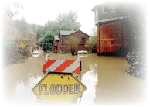California Signs Memorandum of Agreement with NOAA/ESRL
June 24, 2008
 Russian River in CA. Credit: Dave Gatley/FEMA. |
The California Department of Water Resources (DWR) has signed a five-year agreement with NOAA's Earth System Research Laboratories (ESRL) to bring 21st century observation and modeling capabilities to bear on the state’s water resource and flood protection issues. The joint project between DWR, NOAA, and the Scripps Institute for Oceanography is part of DWR's Enhanced Flood Response and Emergency Preparedness (EFREP) project. The underlying goal of the project is to improve precipitation forecasts, especially during extreme events. The planned statewide deployment builds on NOAA's Hydrometeorological Testbed (HMT) project carried out in the North Fork of the American River over the past 3 years. Recent research indicates that extreme precipitation in California is often associated with land-falling atmospheric rivers. Over the ocean the moisture content of these rivers can be tracked by weather satellites, however, over land ground-based instruments are needed. The planned deployment of instrumentation represents the first tier of a proposed multi-tier program. Taking full advantage of the new measurements will require a complementary effort in data assimilation, modeling and display. Decision support tools to integrate this new information into flood forecasts will also be developed.
California's aging water supply and flood protection infrastructure is being challenged by the effects of age, increased standards for urban flood protection, and projected climate change impacts. The work undertaken by ESRL under the EFREP project will test and implement new climate and weather observing and forecasting techniques for responding to these challenges. There is a built-in conflict between providing flood protection and the other functions of major water storage facilities in California: water supply, water quality, hydropower generation, water temperature and flow for at risk species, and recreation. Flood protection is provided by keeping empty flood control storage space behind the dams during the flood season. All other users would prefer fuller reservoirs, if possible. In order to accomplish this goal, improved forecasts of precipitation, especially during extreme events, will be required.
Floods cause more damage nationwide than any other type of natural disaster. The HMT in California has provided an opportunity for NWS hydrologists and meteorologists to work closely with researchers from OAR to develop and evaluate new methods of monitoring and predicting the extreme precipitation that leads to floods. The EFREP project will provide an HMT legacy for California, extending lessons learned in the American River Watershed to other watersheds throughout the state. The EFREP project also will serve as a model for other states to consider, particularly those that are impacted by hazardous weather and where hydrologic disasters are a concern. This research supports NOAA's mission goal of serving society's needs for weather and water information.
| Contact: Allen White |